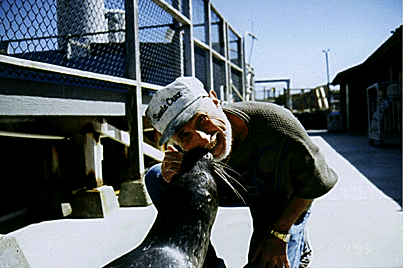![[Currents header graphic]](/homeart/currents_header.gif)
![[Currents header graphic]](/homeart/currents_header.gif)
August 18, 1997

|
|
Ronald Schusterman, with Sprouts
|
By Robert Irion
A remarkable quartet of trained marine mammals is helping scientists push the frontiers of animal psychobiology by demonstrating, in unprecedented detail, how they see, hear, and think about the world around them.
Years of careful experiments at UCSC have painted a fascinating picture of the sensory and cognitive experiences of pinnipeds--the four-flippered, amphibious carnivores that include elephant seals, sea lions, and harbor seals. Their awareness of the world, it seems, has evolved to meet both the general needs of marine mammals and the special challenges each species faces in day-to-day life.
The research is revealing how human impacts might hinder a pinniped's abilities to identify family or foe, communicate, navigate, and solve other problems. The work also illuminates the roots of language development: At least one of the animals can form complex nonverbal relationships among objects, an ability that some researchers had ascribed only to humans.
"Animal behavior is intriguing because they don't have language--they don't code the world around them in symbols, as humans do," said Ronald Schusterman, adjunct professor of biology and ocean sciences at UCSC. "Yet they do so many intricate things, both socially and in terms of foraging, navigating, and avoiding predators like great white sharks and pods of killer whales. These behaviors are very versatile and flexible. Our animals aren't thinking verbally, but we know that they're thinking."
Schusterman's team, based at UCSC's Joseph M. Long Marine Laboratory on the shores of Monterey Bay, has earned a reputation as one of the best in the world for studying the intelligence of marine mammals. In recent years, the researchers have extended their focus beyond animal cognition to encompass the broader issue of how their subjects gather and process information--in essence, mapping the "perceptual world" of a pinniped.
"We take an integrated and systematic approach to studying problem solving in our animals," said marine biologist Colleen Reichmuth, who received her master's degree under Schusterman. "It's difficult to do that if you don't understand what kind of sensory information the animal takes in from its environment."
All of the blubbery and engaging actors in this scientific play were born in captivity or rescued as stranded orphans. Their training and research sessions are voluntary, refined to precise protocols during Schusterman's four decades in animal experimental psychology.
Two of the animals are female California sea lions (Zalophus californianus). Rocky, the eldest at age 21, mastered a sign language under Schusterman in the 1980s. Her cautious approach to new experiences reflects her one year in the wild as a pup (photo). Rio, hand-raised at the lab and now age 12, is like an eager and demanding child. By all appearances she loves her role as a scientific pioneer, splashing excitedly from task to task and excelling at all of them (photo).
Sprouts, a nine-year-old male Pacific harbor seal (Phoca vitulina richardsii), is laid back compared to his raucous neighbors but has yielded important insights in the vision and hearing projects. Four-year-old Burnyce, the world's only trained northern elephant seal (Mirounga angustirostris), can be stubborn and sluggish (photo). But she's caught on surprisingly well and has offered glimpses of the amazing evolutionary adaptations of these deep-diving animals.
"All of them are fun to work with and wonderful to train," said Schusterman. "There's a lot of similarities between them and us. They have emotions and motivations, just as we do, and many of the same basic needs. The ways in which we and they react to the world are not all that different."
The following links provide brief overviews of research highlights from each of the three project areas.
Cognition: Precursors to language?
An apparatus that looks similar to the child's game "Concentration" has garnered the group much attention over the years. Schusterman's coworkers train Rocky and Rio to match pairs of pictures, exposed within small windows in a poolside wooden frame. For each correct pairing (identified by the sea lion with a touch of its nose), the animal gets a fish. We see each symbol as a letter, or a flower, or a teapot--but to the sea lions, they're just random shapes.
Hearing: The din of the ocean
Pinnipeds may not talk, but they growl, bellow, snort, whine, and caterwaul with abandon. All of this helps make the ocean and onshore breeding grounds very noisy places indeed. Add the cacophony of civilization and industry, and one might wonder how marine mammals hear what they need to hear.
Vision: To the depths, darkly
Do pinnipeds hear their prey, or do they see them? Schusterman's hypothesis is that it's both, but primarily the latter: Those big watery eyes just soak up photons, even at great depths.